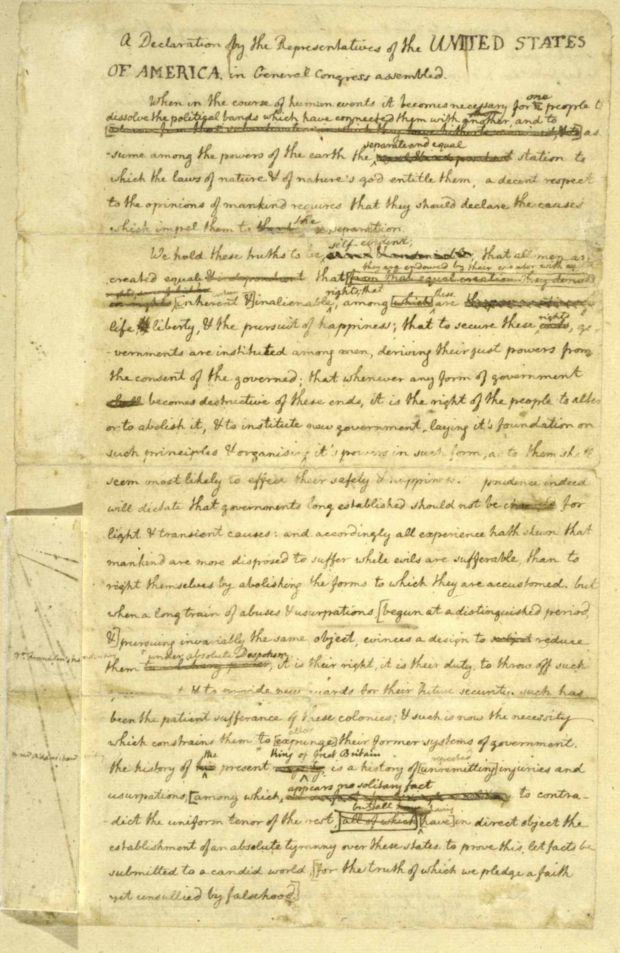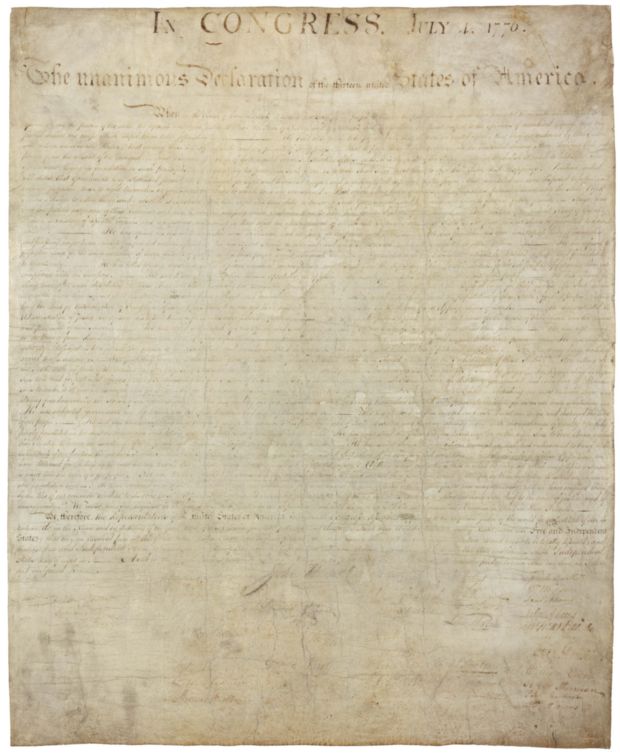Jefferson and the Declaration of Independence
Reading Level: Elementary School
In early May, 1776, Jefferson traveled to Philadelphia to be a delegate to the Second Continental Congress. After a week’s journey, he arrived in Philadelphia. He was thirty-three years old, the youngest member of the Congress.
The Committee of Five
Congress picked a committee to write a declaration explaining why the colonies wanted independence. They chose John Adams of Massachusetts, Roger Sherman of Connecticut, Benjamin Franklin of Pennsylvania, Robert Livingston of New York and Thomas Jefferson of Virginia.
Jefferson was not a great speaker. John Adams said of Jefferson, “During the whole time I sat with him in Congress, I never heard him utter three sentences together.” But he was known for his writing skills. The committee of five men picked Jefferson to write the declaration proclaiming the independence of the colonies.

Page 1 of Jefferson’s copy of Rough Draft of the Declaration of Independence.
Writing the First Drafts of the Declaration
The committee met several times to talk about ideas and organization. Then Jefferson drafted (made a rough copy) a declaration. He worked for two and a half weeks in the parlor of his rented rooms in a brick building on Market and Seventh Streets in Philadelphia.
Jefferson would rise before dawn and have tea and biscuits. He’d sit down at his “plain, neat, convenient” writing desk that he had designed. He wrote with a quill pen, ripping up many drafts. A small piece of an early draft remains. It shows how he changed many of his words.
Where did Jefferson get his Ideas?
Thomas Jefferson didn’t use any books to help him write the Declaration of Independence. But since his early days, he’d read many important books. He’d discussed ideas about equal rights with teachers and other delegates. He’d also worked with men like George Mason. Like Jefferson, Mason was a plantation owner in Virginia. Mason was the first to suggest that “pursuing happiness” was an important right.

Engraving of the Declaration of Independence. Image courtesy the National Archive and Records Administration
All Men are Created Equal
As Jefferson wrote the declaration, he linked many of these ideas. In the first part, he wrote that all men have rights. These included “Life, Liberty and the pursuit of Happiness.” He wrote that the colonies were no longer bound to England. He wrote that governments should get their power from the people, not a king.
In another section, Jefferson listed the charges against King George III. One was “imposing taxes on us without our Consent.” Another was “cutting off our Trade with all parts of the world.”
Jefferson also drafted a section attacking the slave trade. He described slavery as against the “most sacred rights of life and liberty.”
Were Changes Made to Jeffersons Declaration?
Jefferson’s draft was shown to Franklin and Adams. They made a few small changes. On June 28th, 1776, they gave the draft to Congress. Delegates from South Carolina and Georgia did not want to sign it. They did not agree with Jefferson’s words against slavery. Some delegates from New England also did not want to sign it. Congress argued for and against. Finally, all language against slavery was taken out of the declaration.
From July 2 through July 4th, Congress made changes to Jefferson’s draft of the Declaration. His words were cut by about a fourth. Congress also included the words of Lee’s Resolution “That these United Colonies are, and of Right ought to be Free and Independent States.” On July 4th delegates from twelve colonies voted for the new declaration.
Independence!
That day, in the late afternoon, Congress approved the Declaration of Independence. John Hancock, president of Congress, signed it. The document was now “legal and binding.”
The Declaration of Independence was read to all in Philadelphia on July 8th. The crowd cheered; church bells rang. By July 15th, all thirteen states had voted for the new declaration. August 2nd, the Declaration of Independence was written. It was signed by the members of Congress, including Thomas Jefferson.

Original copy of the Declaration of Independence at the National Archives in Washington, DC. Image courtesy the National Archive and Records Administration
What does the Declaration Mean Today?
The Declaration of Independence is a famous document for many reasons. It declared the colonies independence from Great Britain. It stated basic rights and liberties for Americans.
As time went by, the ideas Jefferson’s words “all men are created equal” grew in importance. Northern states used them to free slaves in their states. Abraham Lincoln used equal rights to justify the Civil War. In 1963, Martin Luther King, Jr. stood on the steps of the Lincoln Memorial in Washington, D.C. In his famous speech he repeated the ideals “that all men are created equal.”
Women used equal rights to fight for the vote. In 1848, a women’s rights meeting wrote that “all men and women are created equal.”

